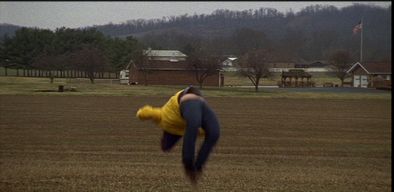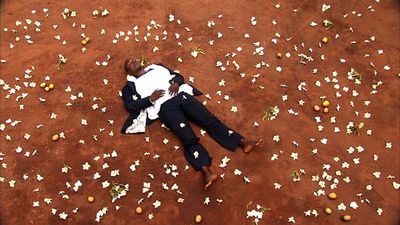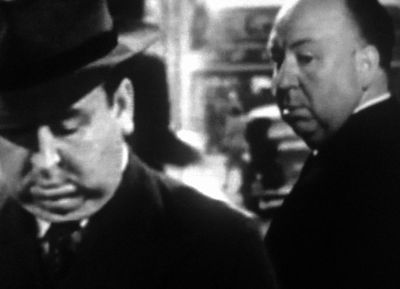Thinking Outside the Docs: A Fortnight of Nonfiction at MoMA
By Kathy Brew
New York City's Museum of Modern Art recently presented its ninth season of Documentary Fortnight, an annual two-week festival of international nonfiction film that takes place each February. This year's festival included 20 feature and 23 mid-length and short works that represent a wide range of creative styles, extending and expanding the idea of the documentary form. In comparison to other documentary film festivals, many of Doc Fortnight's selections could be considered to be more on the "arty" or experimental end of the spectrum. As Sally Berger, organizer of the program and Assistant Curator of Film at MoMA, states, "Because Documentary Fortnight is organized for an art museum and does not include a market, as a festival the atmosphere is focused on bringing to audiences screenings and discussions on artistic creativity and the content of the nonfiction form." After all, why not focus on the "art" part of the form at a venue devoted to art?
One program that fell more into the "art spectrum" was Community and Collaborative Filmmaking: Directors and Subjects, which featured several programs around notions of community and collaborative filmmaking. This featured the work of Jeannie Simms (The Readymades, 2008 & 2009), Patty Chang (Minor, 2010), Liza Johnson (In the Air, 2009), and Sharon Lockhart (Podwórka, 2009). All of these makers are as known and represented in the museum and gallery arenas as they are on the independent film circuit, and their practice is informed by hybrid crossovers between these two realms. Each filmmaker was present for the post-screening discussions, which explored the different means of creation in collaboration with the filmmakers' subjects, using varying degrees of participation, performance and observation. For example, In the Air, which premiered at this year's Berlin Film Festival, combines elements of fiction and documentary, where Johnson used an improvisational, role-playing process with her subjects in which everyone submitted ideas and she then remixed those ideas. In Podwórka--also shown at this year's Berlin Film Festival along with two other films by Lockhart--the artist uses an observational style to capture children at play in the courtyards of Lodz, Poland. For her, the work is more a study of a specific place--the architecture and its space--versus "a documentary." In fact, during the post-screening discussion, Lockhart commented on how documentary is a "complicated word," perhaps implying that these artists are seeking innovative approaches in their work so as not to allow it to be locked into any single form. In each work, how subjects present themselves and their experiences, and the power of representation and its meaning for the participants, were explored from unique and unusual perspectives.

Continuing with the notion of performance, Nora (2008), a multiple award-winning short film by Alla Kovgan and David Hinton, is a stunning visual/aural experience, based on the true story of dancer Nora Chipaumire, who returns to her native Zimbabwe and takes a journey through some vivid memories of her youth, bringing the story to life through performance. The story is an amalgamation of several genres--bio-pic, fable, dance film -- moving back and forth between joy and sorrow, and comedy and tragedy. There is no sync sound or audio narrative, and the performance with sound and image is accompanied by occasional short intertitles to fill in any gaps. There's a powerful score by Thomas Mapfumo, recognized for the political influence he wields through his music. The filmmakers said of their work, "We were trying to create reality, not depict reality."

A few of the films at this year's Doc Fortnight represented a salute to the Jan Vrijman Fund, associated with the International Documentary FilmFestival Amsterdam (IDFA), which supports filmmakers in developing countries. One of those films was Massoud Bahkshi's Tehran Has No More Pomegranates! (2008), a sarcastic and comic portrait about the Iranian capital's transformation from a small village to a bustling modern metropolis. Using a collage mix of archival footage from the past 100 years, modern images of Tehran, and music and sound, the film brings the aesthetic and cultural values of old and new Tehran to life, both a celebration of what Tehran is and a mourning for what it could never be. As the introduction to the film states, it is "a musical, historical, comedy, docu-drama, love story, experimental film" that uses style and subject to capture the chaotic and paradoxical soul of Tehran.
Focusing on the modern metropolis and contemporary urban issues on a more local level, Diane Nerwen's Open House (2009) documents the transition of Williamsburg, Brooklyn from a traditional, somewhat rundown family neighborhood to a gentrified extension of Manhattan where "old world charm blends with the avant-garde" and high-rise condos have been designed to lure upwardly mobile yuppies seeking a high-end lifestyle at cheaper-than-Manhattan prices. The piece is divided into chapters--Removal, Vacancy, Construction, Replacement--with visuals brutally revealing the destruction and demolition of buildings and the ongoing construction of new ones intermixed with off-camera voices--the seductive lures of the real estate marketing come-ons juxtaposed with comments of longtime residents from "the ‘hood" talking about the changes. Open House is an elegy for yet another destroyed neighborhood.
The closing night presentation offered the New York "avant-premiere" of Double Take by Belgian filmmaker Johan Grimonprez, with the filmmaker present for Q & A following the screening. (The piece was also presented at Sean Kelly Gallery in New York in 2009.) The theme of döppelgangers and doubling is built around a story written by novelist Tom McCarthy that draws on a tale by Jorge Luis Borges. Double Take is a hybrid experimental collage that mixes clips of Alfred Hitchcock in person and re-enactment (through the use of a professional Hitchcock look-alike) placed in the setting of American culture during the Cold War as represented through a range of diverse media--broadcast television, clips from Hitchcock features, commercials and more. Double Take literally gives us a double take, and much more than a second take, on some of the era's major significant world events. It's as if we rewind and relive those times through the media Grimonprez serves up--the Nixon-Khrushchev "kitchen debate," the Kennedy-Nixon presidential debates, the Cuban missile crisis, the space race, Kennedy's assassination and more. Double Take evokes a poignant nostalgia for a past that was characterized by prosperity and an innocent consumerism, yet at the same time underscores the beginning of the anxiety and paranoia--the dark side of the American Dream--where all was possible, including nuclear annihilation. The accretion of all this media offers up the basis for our current climate of catastrophe and fear, which has exponentially escalated since Cold War times through the onslaught of information overload in our post-9/11 world. Double Take raises questions about the dominance of the image, the unreliability of memory, the mutability of identity and the tendency of life imitating art--in this case, movies. Here, we are all stars in our current B movie, where the global rise of fear and terror is the zeitgeist of the moment.

While the film is not likely to be released in suburban multi-plexes, Kino International plans for a June theatrical release at Film Forum in New York.
Clearly, the ambiguities of the documentary form were raised through many programs in this year's Documentary Fortnight. One of the directors even said in his introduction that he felt a bit disingenuous by showing his film in a documentary festival. But as Berger notes, "To my mind, the documentary form is an inspiring genre because it is expansive. The term documentary encompasses a range of filmic approaches, and is constantly being re-imagined. This is what we try to reflect in Documentary Fortnight."
Kathy Brew is an independent filmmaker, media arts curator and writer, who also teaches at The New School, The School of Visual Arts and Rutgers University.
